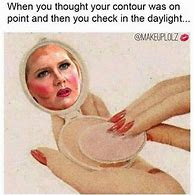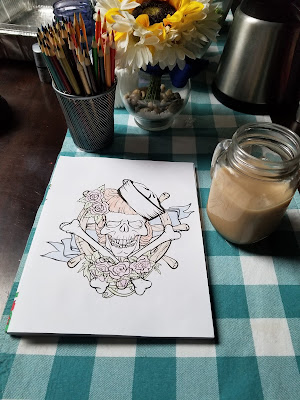Makeup 101: Skin Coverage Tips and Tricks
Skin Coverage Tips and Tricks
We’ve all had that day/night when we got all dolled up
to go out and thought we looked smoking’…until we caught a glimpse of ourselves
in the car mirror. Our foundation color
is wrong, our concealer is covering NOTHING, and a “light dusting” of powder
really looks like we were involved in a tragic baking accident.
Now these tips refer mainly to drugstores and places
where you can’t try the product before you buy it, like Walmart or Target. In places like Ulta or Sephora when you’re
buying the expensive stuff, they can give you a sample to try, which I
definitely recommend. I would not recommend trying drugstore products in the
store anyway. I just think it’s not hygienic and gross. Do yourself a favor and
NEVER pick up anything at the drugstore unless you can absolutely tell it hasn’t
been used. Just don’t take a chance.
So here are a few tips to help you
avoid an unfortunate comparison to an Oompa Loompa (or a certain commander in
chief with a bad spray tan).
Research Return Policies
When buying makeup of any kind at the drugstore,
definitely look into their cosmetic return policies. It sucks when you take
home a sealed package and as soon as you open it, you realize you hate it. This
is especially true for face makeup. It’s so hard to pick out the right shade
and finish because you not only have to take skin tone into account, but also
undertone, type and texture. Also, some formulas might not agree with your
skin. I’ve mentioned before that my skin tone is super hard to match, but I’m
also sensitive to certain brands. So please don’t waste your money, and make
sure you can return it.
Choosing foundation for skin type
If you have oily skin, go for anything that says “mattifying”
or “matte finish.”
 |
| L'Oréal Pro Matte Foundation |
If you have normal to combo skin, go for a traditional
liquid foundation.
 |
| My fave: Rimmel Match Perfection |
If you have dry skin, try a cream formula (just don’t
grab one that says “cream to powder.” It will make dry skin more noticeable.)
 |
| Revlon ColorStay Whipped Crème Foundation |
Choosing foundation for coverage
If you have barely anything to cover, you can get away
with something that says light to medium coverage.
 |
| Wet n' Wild PhotoFocus |
If you have a little redness or discoloration, go for
a medium coverage.
 |
| L'Oréal True Match |
If you have a lot of cystic acne or something large to
cover, go for a full coverage.
 |
| L'Oréal Total Cover |
Eyeball it, then pick three
Choosing foundation at the drugstore, but you’re not
sure which shade to choose? Eyeball what looks like your general skin tone.
Grab that one, and grab the one to the left and the one to the right (just make
sure they’re in the right place and that it matches the color label on the
shelf). Yeah, it’s a big investment (temporarily, because we researched our
return policies RIGHT???) but you might only need one or none at all. Some are just
duds!
 |
| Eyeball your general skin tone, then choose the next one up and the next one down |
Match your skintone, don’t change it!
I know, we all want that summery glow all year round,
but that’s what bronzer is for. PLEASE don’t try to make your skin darker with
foundation. When looking for your shade,
always match it at your collarbone. Many people say your neck or jawline, but
many people still have redness at their jawline (hormonal breakout, anyone?) or
discoloration at their necks (especially people who are insulin resistant. We
tend to have some hyperpigmentation on our necks that makes it look dirty.) The
collarbone is the easiest place to find an overall match to both your face and
chest, especially if you don’t plan on wearing a turtleneck very often. Make
sure you check it out in natural lighting and not just at home or in the store.
Also, do yourself a favor: if it looks
orange or pink in the tube, DON’T get it. No one’s skin has that pink of an
undertone.
Concealer types
Picking a concealer tends to be a little easier, as there
aren’t as expansive color selections for them. It’s usually just fair, light,
medium, and deep. I like a creamier option, because it sets easily with powder
or setting spray. I just find that many of the liquid types (the ones that come
in what looks like a lip gloss tube) just tend to not have enough buildability
to cover. Just test it out when you get home to make sure it isn’t dry.
 |
| Revlon PhotoReady Concealer |
When it comes to covering dark circles, it might get a
little tricky. Not many drugstore brands sell undereye concealers. Covering that type of discoloration requires
something with an orangey or peachy tone to counteract the blue in the circles.
 |
| A Mommy's Best Friend: Nyx Under Eye Concealer |
Making it last
For most people, a powder works just fine. For beginners, I
would recommend a pressed translucent powder with the fluffiest brush you can
find so you don’t use too much (and once you get the product on it, tap off the
excess).
 |
| Rimmel Stay Matte Translucent Powder |
There are exceptions
to this rule, though.
If you have dry skin, go for a setting spray instead.
Remember how I said you don’t want a cream to powder foundation? Powder is the
devil, especially if you have flaky skin.
 |
| Avon True Color Setting Spray |
If you are still concerned about some discoloration after
foundation AND concealer, it’s ok to use a powder that matches them. Just used
pressed. It’s easier to handle than a loose powder if you’re not used to it.
 |
| Neutrogena Mineral Sheers Powder Foundation |
There they are: my tips and tricks for a flawless base. If
there was something specific you want to know, but I didn’t go into it, let me
know in the comments.
Coming up in the Makeup 101 series: contouring. Stay tuned!





Comments
Post a Comment